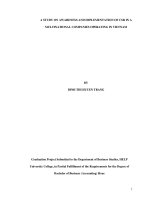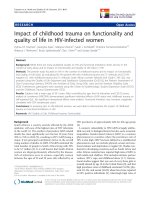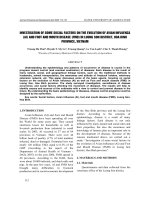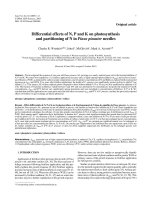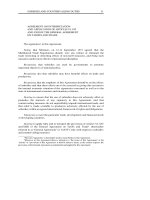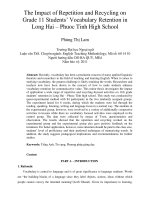Climate change impact assessment on capture and culture of lobster in ninh hai district, ninh thuan province
Bạn đang xem bản rút gọn của tài liệu. Xem và tải ngay bản đầy đủ của tài liệu tại đây (2.65 MB, 75 trang )
MINISTRY OF EDUCATION AND TRANNING
NHA TRANG UNIVERSITY
----------------------------
NGUYEN HONG TRUONG
CLIMATE CHANGE IMPACT ASSESSMENT ON CAPTURE
AND CULTURE OF LOBSTER IN NINH HAI DISTRICT,
NINH THUAN PROVINCE
MASTER THESIS
KHANH HOA – 2017
MINISTRY OF EDUCATION AND TRANNING
NHA TRANG UNIVERSITY
----------------------------
NGUYEN HONG TRUONG
CLIMATE CHANGE IMPACT ASSESSMENT ON CAPTURE
AND CULTURE OF LOBSTER IN NINH HAI DISTRICT,
NINH THUAN PROVINCE
MASTER THESIS
Marine Ecosystem based Management
Major:
and Climate Change
Code:
Topic allocation Decision
772/QĐ-ĐHNT dated 20/9/2016
Decision on establishing the
Committee:
461/QĐ-ĐHNT dated 16/5/2017
Defense date:
3/6/2017
Suppervisors:
Assoc. Prof. NGO DANG NGHIA
Prof. AKHMAD FAUZI
Chairman:
Assoc. Prof. PHAM QUOC HUNG
Faculty of Graduate Studies:
KHANH HOA – 2017
UNDERTAKING
I undertake that the thesis entitled: “Climate change impact assessment
on capture and culture of lobster in Ninh Hai district Ninh Thuan province”
is my own work. The work has not been presented elsewhere for assessment
until the time this thesis is submitted.
Nha Trang, date 2nd May, 2017
Nguyen Hong Truong
iii
ACKNOWLEDGMENTS
I want to express my sincere grateful to the following organizations and
persons for their invaluable support, help and encouragement to me in
conducting this study:
Marine Ecosystem based Management and Climate Change in Norhed
program for giving me the opportunity to study and conduct this master thesis
on Marine Ecosystem based Management and Climate Change.
I would like to express special appreciation to my supervisor,
Assoc.Prof.PhD: Ngo Dang Nghia and Prof.PhD: Akhmad Fauzi who I have
learned a lot from his guidance, useful advices and valuable comments
throughout the study period.
I would you like to thank Locals and Agencies in Ninh Thuan for their
helps on collecting primary and secondary data.
Finally, I would like to express my sincere gratitude to my small family
(my wife, daughters), friends, classmates and colleagues for their love,
encouragement and help.
Nha Trang, date 2nd May, 2017
Nguyen Hong Truong
iv
LIST OF CONTENTS
UNDERTAKING .......................................................................................................... iii
ACKNOWLEDGMENTS ............................................................................................. iv
LIST OF CONTENTS.....................................................................................................v
LIST OF SYMBOLS .................................................................................................. vii
LIST OF TABLES....................................................................................................... viii
LIST OF FIGURES ....................................................................................................... ix
ABSTRACT .................................................................................................................. xi
INTRODUCTION ...........................................................................................................1
CHAPTER 1: OVERVIEW..........................................................................................3
1.1. An overview of aquaculture and capture of lobster Ninh Thuan province .....................3
1.2. Role of capture and aquaculture of lobster in Ninh Thuan province .......................6
1.3. Equipment and tools ................................................................................................7
1.4. The main factors influence lobster development ...................................................11
1.4.1. Depth factor ......................................................................................................... 11
1.4.2. Sea-bottom topography (Seabed structure): ........................................................ 12
1.4.3. Sea water temperature ......................................................................................... 13
1.4.4. Salinity factor: ..................................................................................................... 14
1.4.5. Wild feed source.................................................................................................. 15
1.4.6. Storm ................................................................................................................... 16
1.4.7. Wave level and wind ........................................................................................... 17
1.5. General of study area..............................................................................................18
1.5.1. Actual state of natural conditions ........................................................................ 18
1.5.2. Actual state of Climate ........................................................................................ 19
1.5.3. Actual state of livelihood of local people............................................................ 30
CHAPTER 2: RESEARCH METHODOLOGY AND DATA COLLECTION....32
2.1. Research targets and objectives..............................................................................32
2.2.1. Research targets................................................................................................... 32
2.2.2. Research objectives and scope of the research.................................................... 32
2.1. Research methodology ...........................................................................................33
2.2. Study area ...............................................................................................................34
2.3. Data collection ........................................................................................................35
v
2.3.1. Observation method, station's equipment and instrument and method of data
processing ......................................................................................................................35
2.3.2. Secondary data..................................................................................................... 39
2.4. Data analysis...........................................................................................................39
2.4.1. Lobster aquaculture data...................................................................................... 39
2.4.2. Climatic factors data............................................................................................ 39
2.4.3. Data processing methods ..................................................................................... 40
CHAPTER 3: RESULTS AND DISCUSSIONS......................................................41
3.1. Assessment of natural conditions and socio - economic in Ninh Thuan province....................41
3.1.1. Assessment of natural conditions ........................................................................ 41
3.1.2. Statistics of socio – economic conditions.......................................................... 41
3.1.3. Economic growth................................................................................................. 42
3.1.4. People's literacy levels and education ................................................................ 42
3.2. Variations in capture and culture of lobster production .........................................43
3.2.1. Variability in culture of lobster production ......................................................... 43
3.2.2. Climatic events ....................................................................................................45
3.3. Relationship between climate events variations and annual quantity of lobster......................46
3.3.1. Annual sea water temperature and quantity of lobster ........................................ 46
3.3.2. Annual average salinity and quantity of lobster .................................................. 49
3.3.3. Annual average sea level rise and quantity of lobster ......................................... 51
3.4. Relationship between climatic events and annual average number of lobster captured
per household...........................................................................................................................54
3.4.1. Annual sea water temperature and number of lobster caught ............................. 54
3.4.2. Annual average salinity and number of lobster caught ....................................... 55
3.4.3. Annual average sea level rise and number of lobster caught .............................. 56
3.5. Discussions ............................................................................................................57
CHAPTER 4: CONCLUSIONS AND SUGGESTIONS .........................................60
4.1. Conclusions ............................................................................................................60
4.2. Suggestions .............................................................................................................61
REFERENCE ................................................................................................................62
vi
LIST OF SYMBOLS
2a
The mesh size of net
EEZ
Exclusive Economic Zone
FCR
Feed Conversion Ratio
IPCC
Intergovernmental Panel on Climate Change
SLR
Sea Level Rise
SWT
Sea water temperature
SPSS
Statistical Package for Social Sciences
PPT
Parts per thousand
vii
LIST OF TABLES
Table 1.1: Annual average sea water temperature .............................................. 13
Table 1.2: Annual average sea water salinity ..................................................... 14
Table 1.3: Annual average air temperature in Ninh Thuan ................................ 20
Table 1.4: Fluctuation of precipitation in Ninh Thuan province ........................ 21
Table 1.5: Annual average relative humidity in Ninh Thuan province .............. 24
Table 1.6: Number of storm effect on in Ninh Thuan province ......................... 25
Table 1.7: Frequency of prevailing wind directions in Ninh Thuan province........ 27
Table 1.8: Mean monthly wind speed in Ninh Thuan province ......................... 29
Table 1.9: Mean speed of major wind directions in different months ................ 29
Table 1.10: Maximum speed of major wind directions in different months ...... 29
Table 2.1: Location of stations in Ninh Thuan provinve .................................... 35
Table 2.2: Observation equipment of stations .................................................... 38
Table 3.1: Population situation in Ninh Thuan province and Ninh Hai district, 2015......41
Table 3.2: Labor situation in Viet Nam and Ninh Thuan province ................... 42
Table 3.3: Gross domestic product ( GDP) in Ninh Thuan province, 2015 ....... 42
Table 3.4: Statistics education level of lobster farmer....................................... 43
Table 3.5: Total lobster production in Ninh Thuan province .......................... 44
Table 3.6: Total lobster capture in Ninh Thuan province................................... 44
Table 3.7: Environment factors in Ninh Hai, Ninh Thuan province ................. 46
Table 3.8: Total number of lobster aquaculture in Ninh Hai district.................. 54
viii
LIST OF FIGURES
Figure 1.1: Catching lobster by gillnet (Binh Son, Ninh Hai district).................. 7
Figure 1.2: Catching lobster by diving (Source: Tan,2013) ................................. 8
Figure 1.3: Catching lobster by trap (Source: Tan, 2013) .................................. 9
Figure 1. 4: Aquaculture by floating cage.......................................................... 10
Figure 1. 5: Aquaculture by dimension of fixed cage....................................... 10
Figure 1.6: Aquaculture by submerged cage ..................................................... 11
Figure 1.7: The depth of seafloor at sea area in Ninh Thuan province............... 12
Figure 1.8: Average sea water temperature in Ninh Thuan province ................. 14
Figure 1.9: Average sea water salinity in Ninh Thuan province ........................ 15
Figure 1.10: Wave level map at East sea in December....................................... 17
Figure 1.11: Wave level map at Southwest sea in August................................. 18
Figure 1.12: Annual average air temperature in Ninh Thuan province .............. 20
Figure 1.13: Annual rainfall, dry season and rainy season in Ninh Thuan......... 22
Figure 1.14: Annual average relative humidity in Ninh Thuan province........... 24
Figure 1.15: Frequency of Annual wind speed in Ninh Thuan province ........... 28
Figure 2.1: Commodity lobster aquaculture activities in Vinh Hy bay .............. 33
Figure 2.2: Research content block diagram....................................................... 34
Figure 2.3: Topography and study area map in Ninh Thuan province .............. 35
Figure 2.4: Map of Net work Hydro-Meteorological in Ninh Thuan ................. 36
Figure 2.5: Observer implemented observations in Phan Rang station.............. 37
Figure 2.6: Observer implemented observations at 7 am, Tri Thuy station ...... 38
Figure 3.1: Fluctuation in lobster production in study area in recent 16 years. ........ 44
Figure 3.2: Fluctuation in number of lobster per household in study area. ........ 45
Figure 3.3: Variations in Sea water temperature................................................. 47
Figure 3.4: Correlation between SWT and lobster production ........................... 48
Figure 3.5: Fluctuations of both lobster quantity and sea water temperature .......... 48
Figure 3.6: Variations in salinity in study area during 2000 to 2015 ................. 49
Figure 3.7: Fluctuations of both lobster quantity and salinity in study area....... 50
ix
Figure 3.8: Correlation between lobster quantity and Salinity ........................... 50
Figure 3.9: Changes in sea level in study area during period 2000 to 2015....... 51
Figure 3.10: Fluctuations of lobster quantity and SLR....................................... 52
Figure 3.10: Correlation between lobster quantity and SLR .............................. 52
Figure 3.12: Average sea level rise and salinity in study area during ................ 53
Figure 3.12: Correlation between salinity and sea level rise during study period...... 54
Figure 3.14: Average sea water temperature and lobster caught ........................ 55
Figure 3.15: Correlation between Annual SWT and number of lobster caught ....... 55
Figure 3.17: Correlation between annual salinity and lobster caught................. 56
Figure 3.18: Annual average sea level rise and number of lobster caught ......... 57
Figure 3.19: Correlation between annual average sea level rise and number of
lobster caught............................................................................................... 57
x
ABSTRACT
This study review affected climate change to aquaculture and capture of
lobster performance of the local community. The aquaculture - capture planning
in Ninh Thuan area marine, Vietnam, is used as the study case, with data
collected from 20 observations of lobster farms and 56 lobster exploitation
households providers.
Developing from 1995s, lobster farming generates super profit and high
internal rate of return in investment. As a small lobster culture region of Ninh
Thuan province, lobster farming career in Vinh Hy bay used to create a number
of jobs for not only farmers, but also for fishers and other locals related to this
farming. In recent years, after the disease outbreak occurred in 2006 and the
storm happened in 2010, there is a phenomenon that farmers in Vinh Hy bay
limit their cages for lobster culturing and transform gradually to culture marine
finfish and other jobs.
By a SPSS statistic analysis model, the role of parameters such as climatic
parameters, lobster production, number of lobster capture per household, culture
time, number of cages, etc.
Salinity affected of lobster production and number of lobster captured
with high correlation coefficients (r = 0.674; p=0.05). For suggestion to farmers
should rational exploitation and structure of sustainable lobster farming in
context to respond with climate change in Ninh Hai district.
The statistical and analysis method are employed for the analysis climatic
factors to find out what factors influence on aquaculture and captured of lobsters
in Ninh Hai district. We demonstrate that aquaculture and capture of lobster has
been both positively and negative influencing on economic well-being of the
people community, but negatively impacted climate change recently years.
Key words: Climate change, lobster production, cage lobster, diving, Sea
level rise, salinity, Sea water temperature, extreme events, Vinh Hy bay.
xi
INTRODUCTION
Climate change is globally considered to be a serious threat, especially for
populattion in coast areas of Viet Nam. The coast is one of themost vulnerable
areas to potential impacts of climate change, particularly because of anticipated
future sea-level rise (Wong et al., 2014). The coastal zone is an important
natural resource system, which provides space, as well as living and non- living
resources for human activities.
The human living near the coast is advantageous for aquaculture and
fisheries, especialy culture and capture of lobster activities in Ninh Hai district
impacts which are exacerbated by climate change, with elevated water levels
becoming more frequent and severe due to intensively aggregated human
activities. There is a need, there- fore, to assess to impacts of climate change on
culture lobster and wild caught lobster.
With a coastline of 3,260 km and an Exclusive Economic Zone (EEZ) of
more than one million km2, Viet Nam has great potential for aquaculture and
fisheries development. In 2010, the total annual seafood production was 5.2
million tonnes wet weight, of which 2.5 million tonnes were from the marine
capture fisheries and 2.7 million tonnes from aquaculture (Nguyen Minh Duc.
2011). Even though the Vietnamese authorities built plans to develop the marine
fisheries, catches landed today may be close to the maximum sustainable yield
(Ministry of Agriculture and rural development, 2005). Therefore, the future
growth of the seafood industry must rely on the development of aquaculture.
The objective of the Vietnamese national plan is to produce 2 million tonnes of
aquaculture seafood by 2020 (Ministry of Agriculture and rural development,
2014). The plan focuses particularly on developing aquaculture species with a
high export value. In addition to generating foreign exchange earnings, the
aquaculture industry is of vital importance for the livelihood of the population in
rural and coastal areas. The development of coastal and marine farming is
crucial to creating new jobs for fishers leaving the captured fisheries due to the
over-exploitation of fish stocks.
Many areas in the coastal zone of Vietnam are suitable for seacage
culture, with more than 4,000 islands and many lagoons and bays giving
1
protection against the waves and wind, which are particularly strong during the
winter monsoon (Ministry of Agriculture and rural development, 1994).
Seacage culture of lobster was developed in 1992, and significant
expansion took place in south central Viet Nam in 2000. The main culture areas
are Phu Yen, Khanh Hoa and Ninh Thuan provinces.
The main species cultured is Green lobster (Panulirus ornatus), Ornate
spiny lobster, among others such as Rock lobster (Panulirus Homarus) and
Red lobster (Panulirus Longipes) etc (Tuan et al. 2000; Tuan and Mao 2004).
Lobster aquaculture production increased markedly between 1999 and 2006, and
reached a peak of approximately 1,142 tonnes in 2006. However, due to ‘milky
disease’ that appeared in late 2006, lobster production has since declined about
863 tonnes.
2
CHAPTER 1: OVERVIEW
1.1. An overview of aquaculture and capture of lobster Ninh Thuan province
Global situation:
Growout lobster aquaculture on the world first appeared very early at
North American, Australia, New Zealand and Southeast Asia, but its actual
development started from 1984 to now. In Australia, lobster source (natural
capture and culture of lobster) is a very important fishery. Lobster culture also
bring significantly profits in New Zealand (Institute No3, 2015).
In countries of Southeast Asia, the lobster farm experiment have been
established since 1970s untill 1990s the lobster farming was thrives in this
country. Main lobster species as: Green lobster (Panulirus ormatus), Red
lobster (Panulirus longipes). In Philippines, the lobster farm experiment have
been established since 1970s, but the first year of 1990s the growout lobster
(commodity lobster culture) was thrives (Institute No3, 2015).
In Taiwan, seed of lobsters was conducted in the pond of 200 cubic
metre (m3), average weight was 25grams/individual, lobster weight was
330grams, rate of survival was 80% after 6 months. The food of lobster is crab,
squip, abalone, mussel, etc (Institute No3, 2015).
Domestic situation:
Lobsers farming in Viet Nam began during the last 1980s. The first year
of 1990s, some of fishermen of Viet Nam have preserved, upgraded small
lobster to commodity lobster culture. Although farming has just culture and
accumulated experience, but the early result showed
that Green lobster
(Panulirus Ornatus) and Rock lobster (Panulirus homarus) have good
growth and thrive in the captivity and this profession has given substantial
profits (Institute No3, 2015).
In the past, lobster farming mainly used lobster cages under bottom
substrate fixed pin, focus culture at the shallow waters, 100 to 500 metres far
3
away from the shore. Many problems such as algae, wastes, pollution,
accumulation of feeds, etc have changed lobster pin cages by the floating cages.
Profits from commodity lobster culture allows lobster farmers to invest
more larger cages, with good and durable material.
The process of traditional culture techniques has been applied to feeding
lobster with fresh feed: low value fish, snail, molluscs, crustaceans and feed
conversion ratio (FCR) often exceeds 20 showing a large amount of organic
material released into the aquatic animal. Besides, appeared more and various
diseases with affected survival rate, growth and quality produce. Dangers still
exist and lobster farming still suffer problems of diseases, especially as milk
disease in 2006, reduced lobster significantly, less than 1,000 tonnes in season
in 2008/2009.
In Ninh Thuan province
Lobster Fishery:
Ninh Thuan is a coastal province of Southern region, with 105km
coastalline, advantageous natural conditions for genus (breeds) lobster culture,
such as areas: My Hiep village (Thanh Hai commune), My Tuong village
(Nhon Hai commune) sand bottom substrate, sandy-mud, coral reef, calm
wind, stable environment etc to consistent with juveniles and larval stages of
lobster. Genus lobster sector began since 1995s when aquaculture department
experimented at Vinh Hy bay (Vinh Hai commune). Since then, production and
value of juvenile lobster fishery is continuously increasing.
Nowadays, juvenile lobster resource which provides commodity lobster
still depend on natural exploitation. High profits brought from juvenile lobster
so farmers captured frequently, continuoul and this caused negative impacts on
the quality of inshore water sources. Effect other breed aquatic species,
especially breed lobster production. Besides, used equipment, rudimentary tools,
small size to brought danger exhausted breed lobster resouses in the future.
4
Grow seedling:
Collected or direct selling for commodity lobster culture, some farmers
sell grow seedlings in province or other localities. In recently, the province has
ten household specialized grow seedling in My Tan, My Hiep village, Thanh
Hai commune with approximately 300 cages and 30 household grow seedling
by commodity lobster produce cages. The main season of grow seedling
lobster capture was from December to April next year. The grow seedling scale
depend on size of cages but range from 500 to 600 individuals/cage.
After grow seedling, the seed lobsters sold for culture households at
localities and Khanh Hoa, Phu Yen, Binh Dinh and Quang Ngai province.
Commodity lobster:
Lobster culture activities in Ninh Thuan region appeared for long time
and focus on two main culture areas, such as: Phan Rang Bay, Vinh Hy Bay.
Species popular is Rock lobster, Green lobster and Red lobster; mainly
cultured by water cages with side 3 x 4 x 4metres, make up a raft floating on
the water with each raft has from 12 to 30 cages.
Feeds used in commodity lobster culture activities is fresh food, wastes
accumulate bottom substrate has been showed sign of organic pollution in the
culture area for long time. For example, by 2008, this region has only 60 cages
of lobster culture. At this time, several farming households began to
experiment commodity lobster culture in Phan Rang bay.
After the effectiveness of lobster culture period, so lobster farming has
gradually extended the scale with relatively large number of lobster cages.
When commodity lobster farm development has brought about some action
development, other service such as net cages, jobs, increased incomes and
improved livelihoods for coastal communities in Ninh Hai district.
Ninh Thuan has more than 450 facilities to seed lobster and
approximately 70 facilities to seed snail. In recent years, the situation of these
5
breeding objects has become more difficutly and unstable. Therefore, requiring
another object of contributing to the diversity of commodity species as well as the
economic development in Ninh Thuan province is required (Institute No3, 2015).
Besides, Ninh Thuan is one of the province has relatively large natural
resource exploitation of lobster annual production of 300,000 to 500,000
units/year, mostly rock lobster (Panulirus homarus). But natural lobster
resource exploitation sharply decrease since 2014 to now (2015).
1.2. Role of capture and aquaculture of lobster in Ninh Thuan province
Describe the potential location for developing culture and capture of
lobster in recent decade.
Since 1995, in Ninh Thuan, commodity lobster has been cultured in
Vinh Hy Bay region (Vinh Hai - Ninh Hai district) bring high economic
efficiency. In 2008, the number of cages have 300 cages at Vinh Hy Bay, but
now reduce only to 60 cages. The period of year 2010 - 2012, lobster activities
have been increased again, however, until early 2013 reduced the number of
cages compared to 2012.
The reason is that farmer used fresh food sources should environment
culture areas in sea region of Vinh Hy Bay, Mi Tuong village and Binh Tien
caused heavily pollutions. Specifically, date: from 5 to 7, May 2012, the
lobster appear some illness and milk disease caused heavy damage to the
lobster farmers.
Ninh Thuan is one of the localities with favorable conditions for the
development of aquaculture breed production. Ninh Thuan province has always
been one of the leaders in terms of yield and quality of brackish water shrimp
(prawn, white shrimp) of the country with over breed production 450 facility.
Ninh Thuan is also one of the provinces with the seed lobster resource
exploitation annual natural relatively large (over 500,000 units/year), which is
largely green lobster. Ninh Thuan has also grow seedling vocational formation
6
served commodity lobster culture, but only in the feed form by cage sinking in
waters close to the wind, rate of survival low, advantages time for this
vocational activities in the short and occur diseases is also very large (Institute
No3, 2015).
1.3. Equipment and tools
Catching by gillnet:
The fishing gear is seine net with 5 mm mesh size (2a = 5 mm). The size
of the seine nets depends on exploitation scale of the fishermen, but typically
the net length varies from 100 metres to 150 metres, with a 4 – 6 metres
height. Netting operation is conducted during night time with a 1000 - 2000 W
fluorescent light placed at the entrance of the seine net. The net is released at
around 8:00 pm and after 4 -5 hours (around 12:00 -1:00 am), it is hauled into
the boat and puerulus lobster is gathered. The net is then released again and
collected around 4:00 am for the second harvesting.
Figure 1.1: Catching lobster by gillnet (Binh Son, Ninh Hai district)
Netting operation terminates at around 5:00 am of the next day. The size
of the collected puerulus are very similar. They are about 7 - 8 mm in total
length, are transparent and weigh about 0.25 - 0.35 gram. The surveyed data on
catching by seine net at some of the bays and gulfs during three years in Ninh
Thuan province showed that prejuvenile numbers have increased and green
7
lobster (Panulirus ornatus) is the dominant species of puerulus/prejuveniles of
green lobster (Panulirus ornatus) caught.
Catching by diving:
Diving to catch the prejuvenile is the most traditional method of collecting
prejuvenile lobster by fishermen in central coastal Viet Nam. This method
results in larger juveniles being caught, from 12 - 15 mm carapace length and 7
- 9 grams body weight, and these have the best survival during culture.
However, the maximum catch is only 100 -150 prejuveniles for a boat with five
divers for 10 days of operation during the main fishing season1.
Figure 1.2: Catching lobster by diving (Source: Tan,2013)
Catching by trap:
Traps are often made of nets of about 60 cm in length and about 40 cm
in diameter. Gap drilled coral is used for the trap, the size of the coral pieces
used varies according to what coral is locally available.
Most of the coral pieces are coral blocks of 2 - 5 kg in weight. The
surface holes are drilled at 10 -15 cm intervals and are 2 - 2.5 cm in diameter.
Wooden traps are drilled to make holes in the same way as those of the coral
1
Current Status and Exploitation of Wild Spiny Lobsters in Vietnamese Waters Nguyen Thi Bich Thuy and Nguyen Bich
Ngoc, 2004.
8
ones. In November every year, the time when lobster prejuveniles are expected
to be found, traps are set into water at a depth of about 4 - 5 metres.
Figure 1.3: Catching lobster by trap (Source: Tan, 2013)
After 3 - 5 days of being placed, every morning fishermen collect the
lobster pre-juveniles by shaking the traps so that the lobster fall into a ringnet.
Alternatively, in shallow water, the prejuveniles can be manually picked from
the drilled holes.
The collected prejuveniles vary from 7.5 - 10 mm in carapace length and
0.3-1gram in body weight. During the peak collection period of January February, as many as 50 - 200 individuals might be taken by one fisherman.
Aquaculture by floating cage
The bag of the floating cage is normally supported by a frame with
buoys and commonly located in waters with a depth of 10 - 20 metres.
Although the initial investment for this kind of cage is high because of the
frame construction, the sustainability of these cages is high with the using
time up to 6 - 10 years. This lobster cage is popularly used in the Vinh Hy
bay and Phan Rang Bay in Ninh Thuan Province ( see figure 1.4).
9
Figure 1.4: Aquaculture by floating cage
Aquculture by Fexed cage
The framework is made of salt-resistant wood. Wooden stakes with 10
-15 cm diameter and 4 - 5 metres length are embedded every 2 metres so as
to create a rectangular or square shape. The bottom area of a farm is
normally 10 - 20 metres square, but may be as large as 200 - 400 metres
square. The cage size also varies. Each cage normally has a cover. The cage
may be on or off bottom. A fixed off-bottom cage is about 0.5 metre above
the seabed. A fixed on- bottom cage is lined with a layer of sand. This kind
of cage is suitable for sheltered bays and behind islands where there is
shelter from big waves and typhoons. This cage is no commonly used in the
Vinh Hy bay in Ninh Thuan province ( see figure 1.5).
Figure 1.5: Aquaculture by dimension of fixed cage
10
Aquaculture by Submerged cage:
The framework is made of iron with a diameter of 15 - 16 mm. The
bottom shape is rectangular or square with an area normally between 1 and
16 metres square. The height is 1.0 - 1.5 metres. The cage has a cover and a
feeding pipe. This kind of cage is common for nursing juveniles in Mi
Tuong village of Ninh Hai, Ninh Thuan province. It is very flexible for
moving from this area to another area when the storm or bad weather
happened (see figure 1.6).
Figure 1.6: Aquaculture by submerged cage
The materials for making cages, such as wood, iron, net, etc., are
available in Vietnam. The marine cages are often of a small size suitable for
a family-scale operation. That is why the number of cages has increased
significantly in recent years. While individual developments may have no
significant impact on the environment or society. A large number of
developments, however, may have significant impacts on the wider social
and economic environment, and on each other (Heen K. & Le A. T., 2007).
1.4. The main factors influence lobster development
1.4.1. Depth factor
The depth impact of the distribution of the wild lobster species.
11
l At the juvenile stage of lobster, they distributed at a depth of 1 to 5
metres water, but at the adult stage of lobster, most of species of lobster
distributed at depth of 5 to 100 metres water, particularly at depth of 180 to
400 metres water as lobster species.
Research by authors
show that, in the central coast of Viet Nam,
Juvenile of lobsters caught in depth 0,5 to 5 metres water. However, in the
same area but different species lived in different depths. For example: green lobster
(Panulirus ornatus), rock lobster (Panulirus homarus), red lobster (Panulirus
longipes) lived in depth of 4 - 6 metres water. Therefore, when nursery lobters
should attention to the depth of the cage, usually 2 to 3 metres water.
Adult stage of lobster distributed at the depth of 10 to 50 metres water,
usually coaral reef, coastal areas and islands.
1.4.2. Sea-bottom topography (Seabed structure):
See figure 1.8 show that Sea-bottom topography is one of the most
important environment factors which decide the distribution of the lobster,
particularly juvenile stage of lobster. Lobster often focused in the cave: rock,
coral, mud, etc.
Figure 1.7: The depth of seafloor at sea area in Ninh Thuan province
Particularly, green lobster (Panulirus ornatus), rock lobster (Panulirus
homarus), red lobster (Panalirus longipes) and lotus lobster (Panulirus
versicolor) often live in caves and caves rock small has flashlight. Bamboo
12
lobster (Panulirus polyphagus) prefer to buried themselves under the sand so
species distributed in the seabed sand and pebbles with algae growth.
1.4.3. Sea water temperature
The sea water temperature level is one of the most importance ecological
parameters, decide the distribution seeds of lobster species. The temperature is
factor to direct impact of natural environmental temperature. In summer, dry
and drought climate, the atmosphere temperature is relatively high, a direct
impact on sea water temperature. In Winter, wet and rainy, the air temperature
is low than 1-2oC. Results of monitoring the sea water temperature in the
recorded and survey ranged from 27.1 - 29.8oC, average sea water temperature
about 28.70C ( see Table 1.1) ( Kevin C. Williams, 2009).
Generally, sea water temperature maintained ranges from 27 - 29oC
suitable for the growth and development of lobster. However when sea water
temperature has increased from 29.5 - 30oC, lobster has an expression to
decreased prey. Sea water temperature suitable for the growth and development
of lobster is in the range of 25 - 300C, however, prolonged rising temperatures
may be cause disease outbreaks (According to Booth, J.D. Kenway, M. (2002).
Table 1.1: Annual average sea water temperature
Unit: 0C
Factors
1
2
3
4
5
6
7
8
9
10
11
12
TMean
27.1 27.3 28.0 29.2 29.8 29.6 29.1 29.0 29.1 29.1 28.9 28.1
TMax
30.8 30.3 31.3 32.4 32.5 32.2 32.0 31.2 32.0 33.0 31.4 31.0
TMin
24.3 25.2 25.8 25.0 26.6 25.3 26.7 26.8 27.0 26.5 25.7 22.9
(Source: Central Region South HydroMeteorological station, 2016)
13
Figure 1.8: Average sea water temperature in Ninh Thuan province
1.4.4. Salinity factor:
Salinity is one of the factor impacted on the lives of lobsters, particularly
juveniles of lobster (seeTable 1.2).
The Salinity recorded ranged from 31 - 35 ‰ (mean: 33.7‰). According
to surveyed data, the sea area in central Vietnam showed that adult lobsters are
living at the depth of 10 meters offshore waters, salinity ranges fluctuated from
30 - 35‰. Therefore, the salinity conditions in sea region of Ninh Thuan
province fixed on the threshold of growth and development of lobster.
Table 1.2: Annual average sea water salinity
Unit: Parts per thousand
Factors 1
2
3
4
5
6
7
8
9
10
11
12
Mean
30.8 30.5 30.7 28.2 30.5 30.5 30.6 30.3 29.5 29.1 28.6 29.8
Max
33.5 33.6 33.6 33.6 33.9 33.8 34.2 33.9 33.8 33.5 33.5 33.5
Min
25.2 23.7 23.2 18.5 26.8 25.2 25.5 25.6 25.6 24.5 25.6 25.6
(Source: Central Region South HydroMeteorological station, 2016)
14

